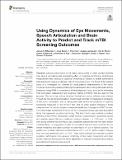| dc.contributor.author | Williamson, James R. | |
| dc.contributor.author | Sturim, Doug | |
| dc.contributor.author | Vian, Trina | |
| dc.contributor.author | Lacirignola, Joseph | |
| dc.contributor.author | Shenk, Trey E. | |
| dc.contributor.author | Yuditskaya, Sophia | |
| dc.contributor.author | Rao, Hrishikesh M. | |
| dc.contributor.author | Talavage, Thomas M. | |
| dc.contributor.author | Heaton, Kristin J. | |
| dc.contributor.author | Quatieri, Thomas F. | |
| dc.date.accessioned | 2022-11-21T17:10:48Z | |
| dc.date.available | 2022-11-21T17:10:48Z | |
| dc.date.issued | 2021-07-06 | |
| dc.identifier.issn | 1664-2295 | |
| dc.identifier.uri | https://hdl.handle.net/1721.1/146570 | |
| dc.description.abstract | <jats:p>Repeated subconcussive blows to the head during sports or other contact activities may have a cumulative and long lasting effect on cognitive functioning. Unobtrusive measurement and tracking of cognitive functioning is needed to enable preventative interventions for people at elevated risk of concussive injury. The focus of the present study is to investigate the potential for using passive measurements of fine motor movements (smooth pursuit eye tracking and read speech) and resting state brain activity (measured using fMRI) to complement existing diagnostic tools, such as the Immediate Post-concussion Assessment and Cognitive Testing (ImPACT), that are used for this purpose. Thirty-one high school American football and soccer athletes were tracked through the course of a sports season. Hypotheses were that (1) measures of complexity of fine motor coordination and of resting state brain activity are predictive of cognitive functioning measured by the ImPACT test, and (2) within-subject changes in these measures over the course of a sports season are predictive of changes in ImPACT scores. The first principal component of the six ImPACT composite scores was used as a latent factor that represents cognitive functioning. This latent factor was positively correlated with four of the ImPACT composites: verbal memory, visual memory, visual motor speed and reaction speed. Strong correlations, ranging between <jats:italic>r</jats:italic> = 0.26 and <jats:italic>r</jats:italic> = 0.49, were found between this latent factor and complexity features derived from each sensor modality. Based on a regression model, the complexity features were combined across sensor modalities and used to predict the latent factor on out-of-sample subjects. The predictions correlated with the true latent factor with <jats:italic>r</jats:italic> = 0.71. Within-subject changes over time were predicted with <jats:italic>r</jats:italic> = 0.34. These results indicate the potential to predict cognitive performance from passive monitoring of fine motor movements and brain activity, offering initial support for future application in detection of performance deficits associated with subconcussive events.</jats:p> | en_US |
| dc.publisher | Frontiers Media SA | en_US |
| dc.relation.isversionof | 10.3389/fneur.2021.665338 | en_US |
| dc.rights | Creative Commons Attribution 4.0 International license | en_US |
| dc.rights.uri | https://creativecommons.org/licenses/by/4.0/ | en_US |
| dc.source | Frontiers | en_US |
| dc.subject | Neurology (clinical) | en_US |
| dc.subject | Neurology | en_US |
| dc.title | Using Dynamics of Eye Movements, Speech Articulation and Brain Activity to Predict and Track mTBI Screening Outcomes | en_US |
| dc.type | Article | en_US |
| dc.identifier.citation | Williamson, James R., Sturim, Doug, Vian, Trina, Lacirignola, Joseph, Shenk, Trey E. et al. 2021. "Using Dynamics of Eye Movements, Speech Articulation and Brain Activity to Predict and Track mTBI Screening Outcomes." 12. | |
| dc.contributor.department | Lincoln Laboratory | |
| dc.eprint.version | Final published version | en_US |
| dc.type.uri | http://purl.org/eprint/type/JournalArticle | en_US |
| eprint.status | http://purl.org/eprint/status/PeerReviewed | en_US |
| dspace.date.submission | 2022-11-21T17:07:35Z | |
| mit.journal.volume | 12 | en_US |
| mit.license | PUBLISHER_CC | |
| mit.metadata.status | Authority Work and Publication Information Needed | en_US |
